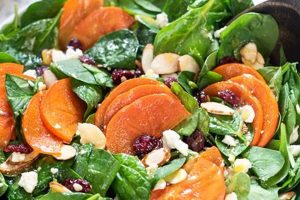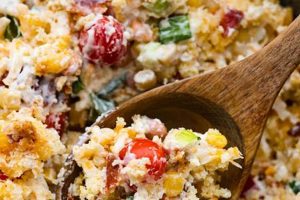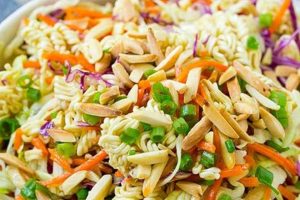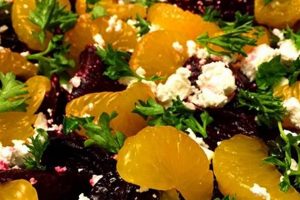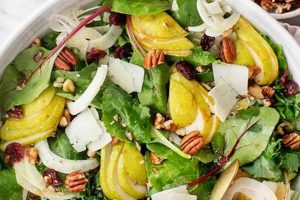The components of a classic Cobb salad typically include chopped chicken or turkey breast, bacon, hard-boiled eggs, tomatoes, avocado, blue cheese, and Romaine lettuce. Variations may incorporate ingredients like chives, watercress, or different cheeses. A vinaigrette dressing, often red-wine based, is traditionally used.
This combination of ingredients offers a balance of protein, healthy fats, and fresh produce, resulting in a nutritious and flavorful meal. The Cobb salad’s layered presentation, with each ingredient arranged in neat rows, also contributes to its appeal. Its origins are attributed to the Brown Derby restaurant in Hollywood in the 1930s, further adding to its enduring popularity.
This article will explore the various elements that contribute to a successful Cobb salad, covering ingredient selection, preparation techniques, dressing options, and potential variations to suit diverse preferences. It will also delve into the historical background of this iconic American dish.
Tips for a Superior Cobb Salad
Achieving a truly exceptional Cobb salad involves careful consideration of each component and its preparation. The following tips offer guidance on optimizing flavor and presentation.
Tip 1: Ingredient Quality is Paramount: Opt for fresh, high-quality ingredients. Vine-ripened tomatoes, crisp Romaine lettuce, and flavorful cheeses contribute significantly to the overall taste experience.
Tip 2: Bacon Perfection: Crispy bacon is essential. Cook bacon until it renders its fat and achieves a desirable level of crispness. Drain thoroughly to prevent a soggy salad.
Tip 3: Proper Protein Preparation: Whether using chicken or turkey, ensure it is cooked thoroughly and seasoned appropriately. Dicing the protein into bite-sized pieces facilitates even distribution throughout the salad.
Tip 4: Avocado Handling: To prevent browning, add avocado just before serving. Ripe, yet firm avocados provide the best texture and flavor.
Tip 5: Egg Excellence: Perfectly cooked hard-boiled eggs are key. Overcooked yolks can be dry and crumbly. Aim for a firm, yet creamy yolk.
Tip 6: Blue Cheese Selection: The sharpness of blue cheese contributes a distinct flavor profile. Choose a quality blue cheese that complements the other ingredients.
Tip 7: The Art of the Chop: Uniformly chopped ingredients ensure a balanced bite and contribute to the salad’s aesthetic appeal.
Tip 8: Dressing Application: Toss the salad components with the dressing just before serving to prevent the lettuce from wilting and maintain the crispness of other ingredients.
By adhering to these guidelines, one can elevate the Cobb salad from a simple dish to a culinary masterpiece. Careful attention to detail in ingredient selection and preparation results in a truly satisfying and memorable dining experience.
These tips offer a foundation for creating an exceptional Cobb salad. The following section will explore variations and adaptations to personalize this classic dish.
1. Crisp Romaine Lettuce
Crisp romaine lettuce serves as the foundational layer of a Cobb salad, providing a refreshing counterpoint to the richer ingredients. Its structural integrity is crucial, offering a bed for the other components while contributing a satisfying crunch. Understanding romaine lettuce’s role and characteristics is essential for a successful Cobb salad.
- Texture and Crispness
Romaine’s firm, crisp leaves hold up well under the weight of the other ingredients and the dressing, preventing the salad from becoming soggy. The crisp texture provides a textural contrast to the creamy avocado, crumbly blue cheese, and other toppings. Wilted or limp lettuce detracts significantly from the overall enjoyment.
- Flavor Profile
Romaine offers a mild, slightly bitter flavor that balances the richness of the other ingredients. This subtle bitterness prevents the salad from becoming overly heavy or cloying. While other lettuces might be used, they often lack the structural integrity and complementary flavor profile of romaine.
- Preparation and Handling
Proper washing and drying are essential for crisp romaine. Excess moisture can lead to a soggy salad. Tearing the leaves into bite-sized pieces ensures even distribution and easier consumption. Adding the lettuce just before serving maintains its crispness.
- Nutritional Contribution
Romaine lettuce provides vitamins A and K, along with some fiber. While not the primary nutritional powerhouse of the salad, it contributes to the overall nutritional value and provides a low-calorie base. Its water content also adds to the refreshing quality of the dish.
The crispness, mild flavor, and structural integrity of romaine lettuce make it an integral part of the Cobb salad experience. Its careful selection and preparation significantly impact the overall quality and enjoyment of this classic dish. No other lettuce variety offers quite the same balance of attributes, making romaine the quintessential base for a proper Cobb salad.
2. Grilled Chicken Breast
Grilled chicken breast stands as a central protein source in the Cobb salad, contributing significantly to its nutritional value and overall flavor profile. Its preparation and inclusion influence the final dish’s taste, texture, and presentation. Understanding the nuances of using grilled chicken breast within the context of a Cobb salad elevates the dish from simple to exceptional.
- Flavor and Texture Enhancement
Grilling imparts a smoky char and enhances the inherent flavor of the chicken breast, adding depth to the salad’s overall taste profile. The process also creates a desirable texture, offering a pleasant contrast to the crisp vegetables and creamy elements. Proper grilling ensures the chicken remains juicy and tender, preventing dryness. This balance of flavor and texture distinguishes grilled chicken from other protein options, such as boiled or poached chicken, which may lack the same depth and textural complexity.
- Nutritional Contribution
Chicken breast provides a lean protein source, essential for satiety and contributing to the salad’s nutritional value. Grilling, a cooking method that requires minimal added fat, helps maintain the lean protein profile. This aligns with the Cobb salad’s balance of healthy fats, fresh produce, and lean protein, offering a complete and nutritious meal. The protein content also contributes to the salad’s ability to serve as a satisfying main course.
- Preparation and Incorporation
Properly grilling and incorporating the chicken breast is crucial for optimal results. Even cooking ensures food safety and prevents dryness. Dicing the chicken into bite-sized pieces allows for even distribution throughout the salad and facilitates easier consumption. Attention to these details enhances the overall dining experience. Improperly prepared or incorporated chicken can negatively impact the salad’s texture and flavor balance.
- Versatility and Adaptability
While traditional Cobb salads feature chicken, variations may substitute other proteins. However, grilled chicken breast remains a popular choice due to its versatility. Its relatively neutral flavor profile complements the other ingredients without overpowering them. Furthermore, it allows for variations in seasoning and marinades, offering opportunities to customize the salad’s flavor profile according to individual preferences or dietary restrictions. This adaptability makes grilled chicken breast a versatile and practical protein choice for Cobb salads.
The careful selection, preparation, and incorporation of grilled chicken breast elevates the Cobb salad experience. Its contribution to flavor, texture, and nutritional value underscores its crucial role as a core ingredient. Understanding these elements allows for a more informed and nuanced approach to constructing a Cobb salad that excels in both taste and presentation.
3. Crispy Bacon
Crispy bacon constitutes a crucial element within the Cobb salad ingredient profile, contributing a distinct salty, smoky flavor and a satisfying textural contrast. Its preparation and incorporation significantly influence the overall balance and enjoyment of the dish. Understanding the role of crispy bacon within this specific culinary context is essential for creating a successful and authentic Cobb salad.
- Flavor and Texture Contribution
The rendered fat and Maillard reaction during cooking imbue bacon with a complex flavor profile characterized by saltiness, smokiness, and a subtle sweetness. This richness complements the other ingredients, particularly the fresh vegetables and creamy avocado. The crisp texture provides a counterpoint to the softer elements, enhancing the overall sensory experience. Undercooked or burnt bacon disrupts this delicate balance, detracting from the intended flavor and texture interplay.
- Preparation Techniques and Impact
Achieving optimal crispness requires careful attention to cooking methods. Pan-frying, baking, or using a microwave can yield varying results. The chosen method influences the bacon’s texture and fat rendering. Properly draining the cooked bacon removes excess grease, preventing a soggy salad. These seemingly minor details significantly influence the final product’s quality and enjoyment.
- Balancing Flavors within the Salad
The saltiness of bacon plays a crucial role in balancing the flavors within the Cobb salad. It enhances the other ingredients without overpowering them. This balance is essential for a harmonious flavor profile. Too much bacon can make the salad overly salty, while too little diminishes its characteristic savory dimension.
- Historical and Cultural Significance
Bacon’s inclusion in the Cobb salad reflects broader culinary trends and cultural preferences. Its widespread appeal contributes to the dish’s enduring popularity. While variations may omit or substitute ingredients, bacon remains a defining component of the classic Cobb salad, highlighting its historical and culinary relevance.
The inclusion of crispy bacon elevates the Cobb salad beyond a simple combination of ingredients. Its flavor, texture, and cultural significance contribute to the dish’s enduring appeal and status as a culinary classic. Careful consideration of bacon’s preparation and its interplay with other ingredients ensures a balanced and satisfying Cobb salad experience.
4. Hard-boiled Eggs
Hard-boiled eggs represent a crucial element within the Cobb salad, contributing not only to its nutritional value but also its textural and visual appeal. Their inclusion adds a layer of complexity that distinguishes the Cobb salad from other composed salads. An understanding of their preparation and contribution to the overall composition enhances appreciation for this classic dish.
- Nutritional Value and Dietary Considerations
Hard-boiled eggs offer a complete protein source, rich in essential amino acids. They also contribute vitamins and minerals, including vitamin D and choline. These nutritional attributes enhance the Cobb salad’s profile as a balanced and satisfying meal. Variations in dietary preferences can be accommodated by adjusting the number of eggs included.
- Textural Contrast and Culinary Impact
The firm, yet yielding texture of hard-boiled eggs introduces a textural contrast to the crisp lettuce, crunchy bacon, and creamy avocado. This interplay of textures elevates the overall sensory experience of the salad. Overcooked eggs, however, can become dry and crumbly, detracting from this desired textural complexity.
- Visual Presentation and Aesthetic Appeal
The quartered or sliced hard-boiled eggs contribute to the Cobb salad’s visually striking presentation. The bright yellow yolks provide a vibrant color contrast against the green lettuce and other ingredients. The precise arrangement of the egg sections adds to the salad’s structured and aesthetically pleasing appearance, enhancing its overall appeal.
- Preparation Techniques and Best Practices
Achieving perfectly cooked hard-boiled eggs requires careful attention to timing and temperature. Overcooking leads to dry, chalky yolks, while undercooking results in a runny consistency. Proper cooling and peeling techniques are essential for maintaining the egg’s integrity and preventing damage. These seemingly minor details can significantly impact the final presentation and overall enjoyment of the salad.
The inclusion of hard-boiled eggs in the Cobb salad elevates it beyond a simple combination of ingredients. Their nutritional value, textural contrast, visual appeal, and careful preparation contribute to a balanced and aesthetically pleasing dish. Understanding the nuances of their role within the salad enhances appreciation for its complex interplay of flavors and textures, contributing to the Cobb salad’s enduring popularity and status as a culinary classic.
5. Ripe Avocado
Ripe avocado contributes a creamy texture and rich, buttery flavor crucial to the Cobb salad’s complexity. Its healthy fats complement the other ingredients, while its vibrant green hue enhances the salad’s visual appeal. A perfectly ripe avocado, yielding to gentle pressure yet maintaining its form when sliced, provides optimal flavor and texture. Unripe avocados offer a subpar culinary experience, detracting from the intended balance. Conversely, overripe avocados can introduce an undesirable mushiness. Selecting ripe avocados is therefore essential for a successful Cobb salad.
The avocado’s role extends beyond flavor and texture. Its healthy monounsaturated fats contribute to the salad’s nutritional value, complementing the lean protein and fresh vegetables. This nutritional profile elevates the Cobb salad beyond a simple combination of ingredients into a balanced and satisfying meal. For instance, the avocado’s healthy fats aid in the absorption of fat-soluble vitamins present in the other ingredients, further maximizing the nutritional benefits. The avocado’s smooth, creamy texture also provides a textural bridge between the crisp lettuce and crunchy bacon, creating a harmonious interplay of textures within each bite. This interplay is a defining characteristic of a well-composed Cobb salad.
Selecting and incorporating ripe avocado requires an understanding of its delicate nature. Timing is crucial; adding the avocado too early can lead to enzymatic browning, while adding it too late risks an uneven distribution. Proper handling, including gentle slicing and careful placement, preserves the avocado’s visual and textural integrity. Mastering the selection and incorporation of ripe avocado ensures that its contribution to flavor, texture, and nutritional value enhances the overall Cobb salad experience. This attention to detail distinguishes a truly exceptional Cobb salad from a mediocre one.
6. Tangy Blue Cheese
Tangy blue cheese forms an integral part of the classic Cobb salad ingredient profile, contributing a distinct pungent and salty flavor that balances the richness of other components. The sharp, piquant notes provided by blue cheese, such as Roquefort or Gorgonzola, contrast with the creamy avocado, crispy bacon, and other ingredients, preventing the overall flavor profile from becoming bland or one-dimensional. This dynamic interplay of contrasting flavors is a defining characteristic of the Cobb salad. Omitting or substituting the blue cheese alters the experience significantly, diminishing the intended complexity. For example, substituting a milder cheese like feta or Swiss cheese, while permissible for personal preference, fundamentally changes the salad’s character. Understanding the role of blue cheese contributes to a deeper appreciation of the Cobb salad’s carefully balanced flavor profile.
The choice of blue cheese also affects the salad’s textural complexity. Blue cheese typically possesses a crumbly texture that contrasts with the crispness of the lettuce and the other ingredients. This textural variation enhances the overall sensory experience. The intensity of the blue cheese’s flavor should also be considered; a particularly strong blue cheese may overpower the other flavors, while a milder one might not provide sufficient contrast. The quantity used also plays a significant role. Too much blue cheese can overwhelm the palate, while too little diminishes its impact. Consider a Cobb salad made with a robust Roquefort; its assertive flavor profile requires careful balancing with the other ingredients. Conversely, a milder Gorgonzola allows for more generous portions without overpowering the salad.
The inclusion of tangy blue cheese exemplifies the Cobb salad’s careful construction. Each ingredient contributes not only to the overall flavor and texture but also to the balance and complexity of the dish. Appreciating the specific role of blue cheese, its interaction with other ingredients, and its impact on the overall culinary experience allows for a more informed approach to both preparing and enjoying this American classic. Challenges in replicating the authentic Cobb salad experience often arise from overlooking the crucial role of blue cheese or substituting it without considering its unique contributions. Balancing these elements is essential for achieving a truly satisfying and authentic Cobb salad.
Frequently Asked Questions
This section addresses common inquiries regarding Cobb salad ingredients, offering clarity on selection, preparation, and substitutions.
Question 1: Can iceberg lettuce be substituted for romaine lettuce?
While iceberg lettuce offers a crisp texture, it lacks the flavor and structural integrity of romaine. Romaine’s mild bitterness and sturdier leaves make it the preferred choice for a classic Cobb salad. Iceberg lettuce tends to become watery and loses its crispness more quickly.
Question 2: Is cooked chicken breast the only suitable protein option?
While grilled or roasted chicken breast is traditional, variations may incorporate turkey breast, crispy tofu, or even salmon. The chosen protein should complement the other ingredients without overpowering the overall flavor profile.
Question 3: What type of blue cheese is recommended?
Roquefort, Gorgonzola, and Danish blue are commonly used. The choice depends on individual preference for sharpness and intensity. Milder blue cheeses can be used for those sensitive to strong flavors.
Question 4: Can the bacon be omitted for a healthier option?
Bacon contributes significantly to the Cobb salad’s characteristic flavor profile. Omitting it alters the experience. If desired, turkey bacon or a small amount of finely diced pancetta can be used as lower-fat alternatives. However, these substitutions will impact the overall taste and texture of the dish.
Question 5: How can avocado browning be prevented after slicing?
To minimize browning, add avocado to the salad just before serving. Alternatively, lemon or lime juice can be lightly brushed onto the exposed surfaces to slow down oxidation. Storing leftover salad with the avocado portions facing down against other ingredients can also help reduce browning.
Question 6: What is the traditional Cobb salad dressing?
A red wine vinaigrette is the traditional choice. Variations exist, often incorporating ingredients like Dijon mustard, garlic, and herbs. The dressing should complement the other ingredients without overpowering their individual flavors.
Understanding the role and characteristics of each ingredient allows for informed choices and substitutions while maintaining the essence of this classic salad.
The following section explores variations and adaptations, providing inspiration for customizing the Cobb salad experience.
Cobb Salad Recipe Ingredients
This exploration of Cobb salad components has highlighted the crucial role each ingredient plays in the final composition. From the crisp foundation of romaine lettuce to the tangy blue cheese, each element contributes a distinct flavor, texture, and nutritional value. The interplay of these carefully selected ingredients creates a balanced and satisfying culinary experience. Preparation techniques, such as achieving optimal bacon crispness and perfectly cooked hard-boiled eggs, further enhance the overall enjoyment. Understanding the nuances of each ingredient allows for informed substitutions and adaptations while preserving the essence of this classic dish.
The Cobb salad’s enduring popularity stems from its harmonious balance of flavors, textures, and nutritional value. Continued appreciation for this culinary classic requires an understanding of its core components and their careful orchestration. By recognizing the significance of each ingredient and its contribution to the whole, one can elevate the Cobb salad from a simple combination of ingredients to a truly exceptional culinary achievement.

